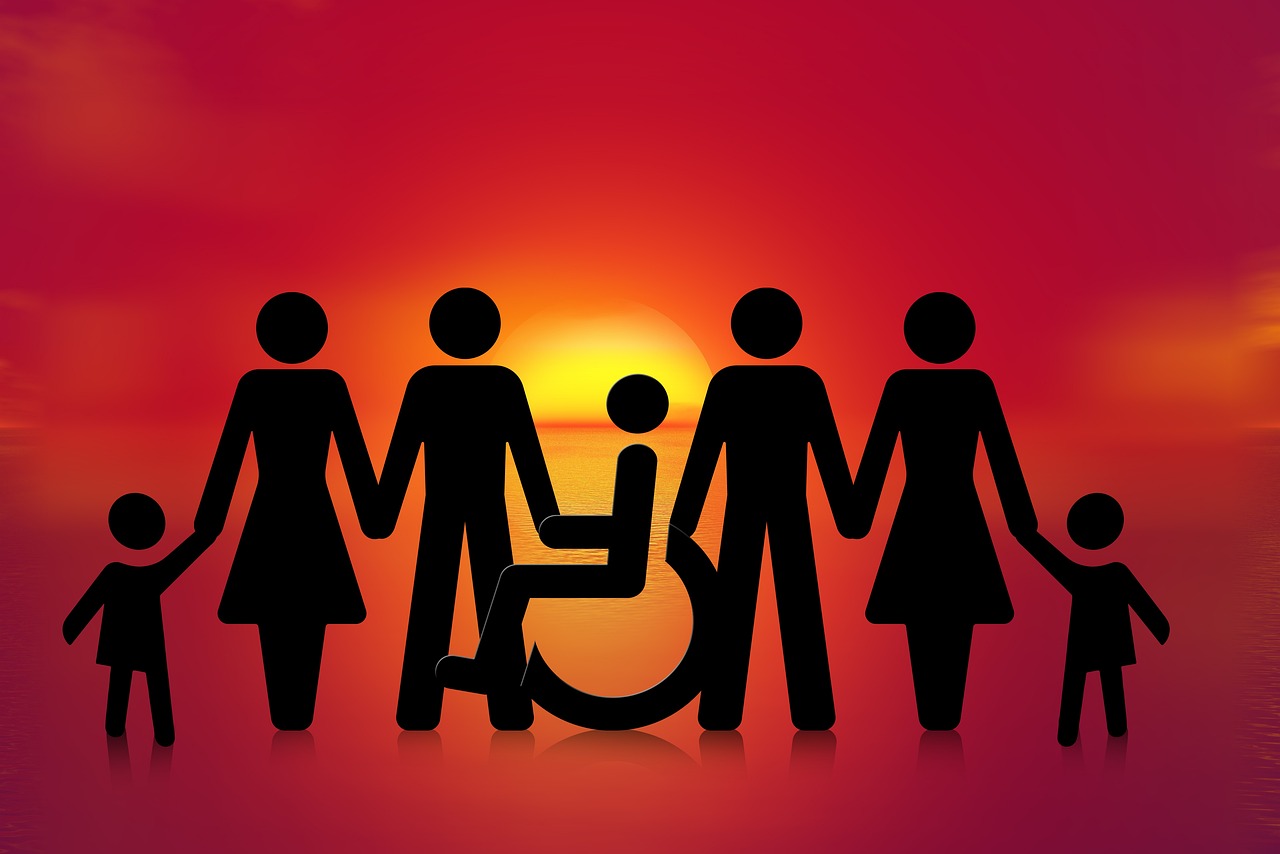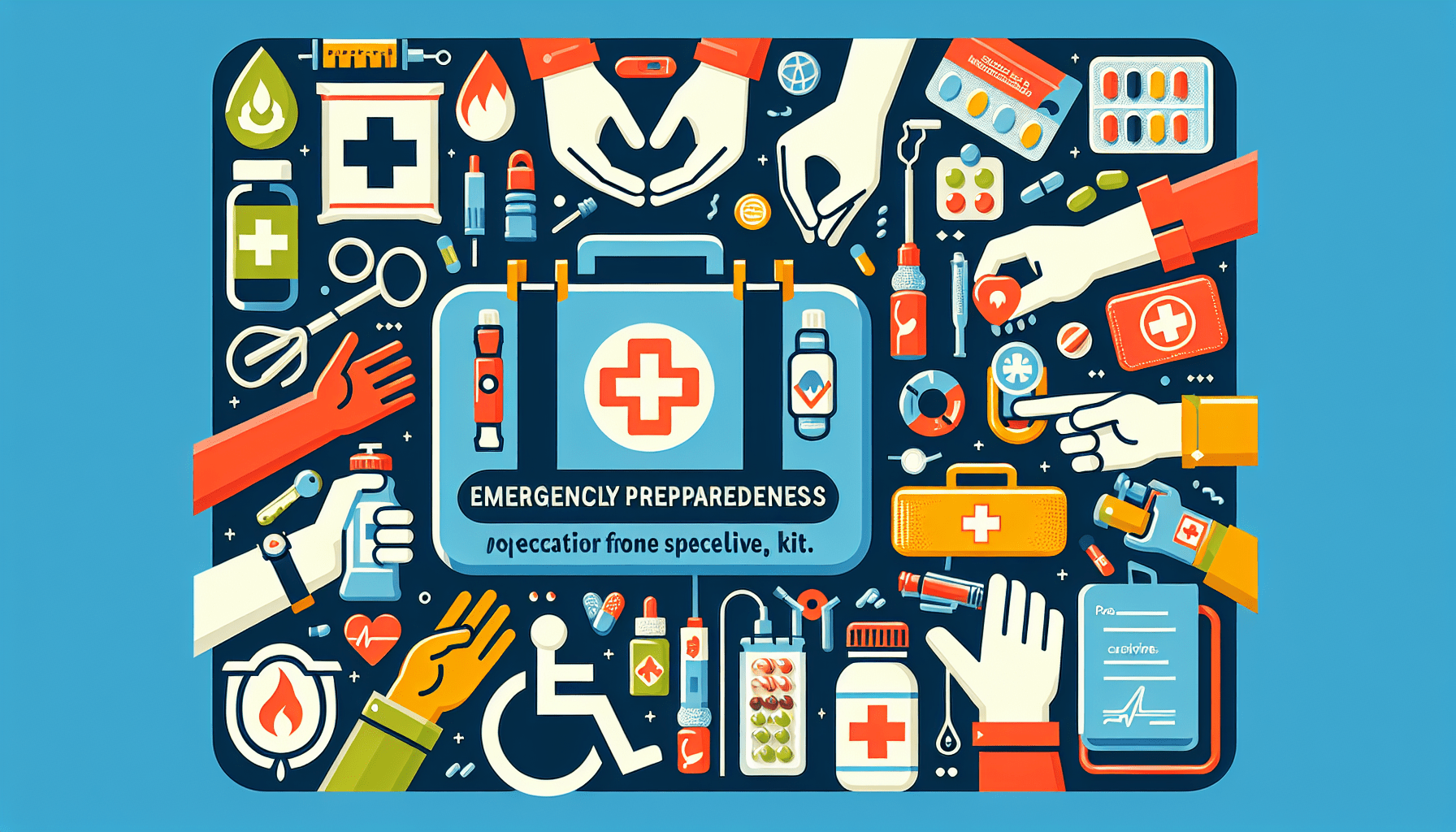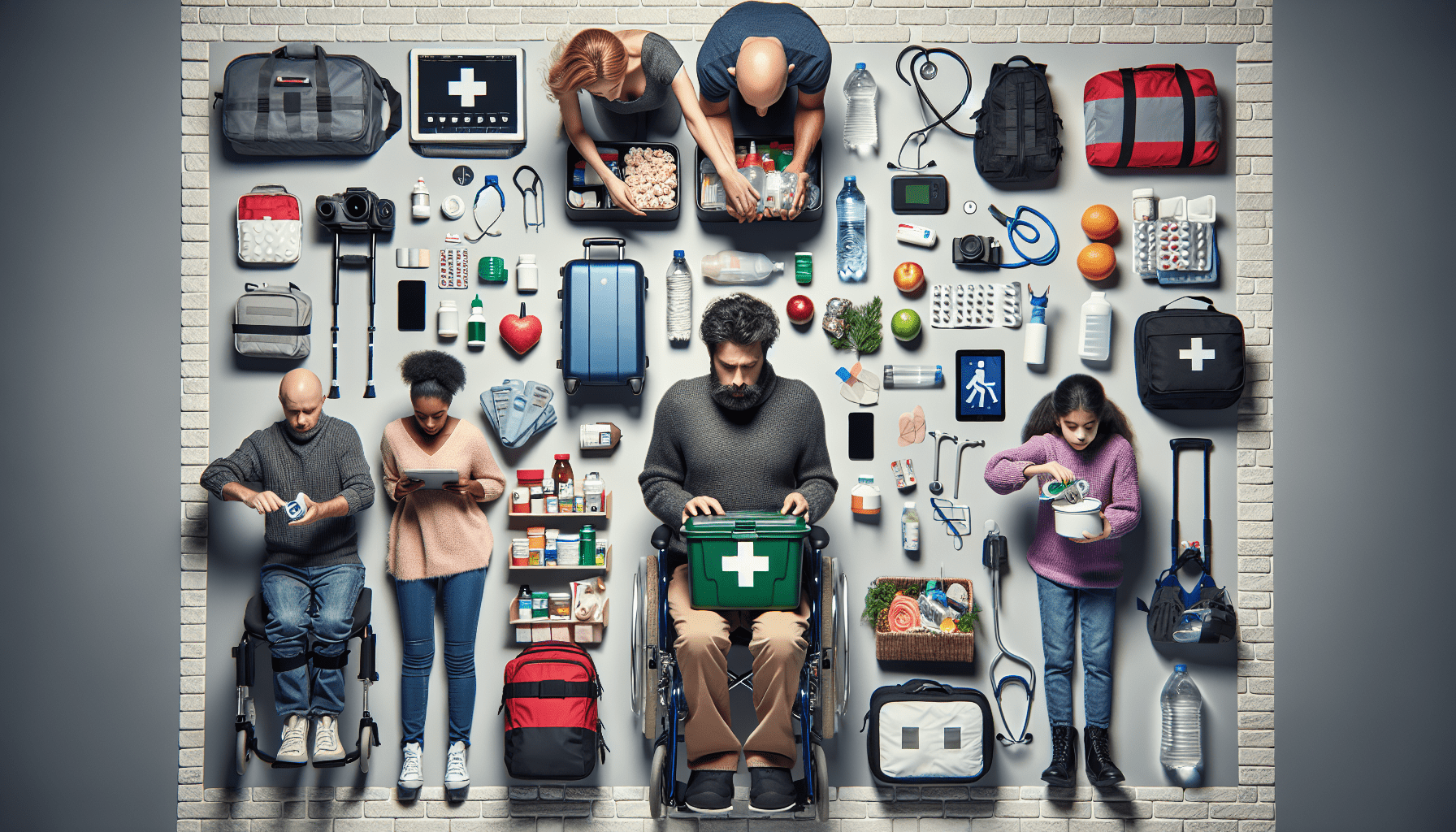In today’s world, it’s becoming increasingly important to be prepared for emergencies. But have you ever stopped to consider how you would handle an emergency if you or your loved one had special needs? Whether it’s mobility issues, sensory sensitivities, or medical conditions, having a plan in place can make all the difference. In this article, we will explore the essential steps to creating a well-thought-out emergency preparedness kit that caters to the specific needs of individuals with special needs. By taking a proactive approach, you can ensure the safety and well-being of yourself and those you care about, no matter the situation.

Identify the Special Needs
Physical disabilities
When creating an emergency preparedness plan for individuals with physical disabilities, it is important to consider their specific needs. This may include ensuring accessibility in both the home and evacuation routes, as well as having the necessary equipment and resources to assist with mobility. Physical disabilities may require the use of wheelchairs, walkers, or other aids, so it is essential to have these items readily available in case of an emergency.
Cognitive disabilities
Those with cognitive disabilities may require additional support to ensure their safety during an emergency. This can be achieved by including visual cues and simplified instructions in the emergency plan, as well as having familiar objects or comfort items readily available. It is also important to consider alternative communication methods for individuals who may have difficulty understanding or expressing themselves verbally.
Sensory disabilities
Individuals with sensory disabilities, such as visual or hearing impairments, have unique needs when it comes to emergency preparedness. Providing accessible information in braille or large print, using visual alarms or vibrating devices, and utilizing alternative communication methods such as sign language or picture-based communication tools can greatly assist those with sensory disabilities during an emergency.
Medical conditions
Those with pre-existing medical conditions require special considerations in emergency preparedness. It is important to have a sufficient supply of necessary medications and medical supplies readily available, as well as a backup power source for any medical equipment that requires electricity. In addition, emergency contacts should be informed about the individual’s medical condition and any specific instructions or precautions necessary.
Mobility impairments
Individuals with mobility impairments face unique challenges during emergencies, particularly when it comes to evacuation. It is essential to identify accessible evacuation routes and establish a plan for assistance or transportation if needed. In addition, ensuring accessible parking spots are available and having mobility aids readily available in the vehicle can greatly assist those with mobility impairments during an emergency situation.
Communication difficulties
For individuals with communication difficulties, it is important to consider alternative methods of communication in an emergency. This can include using picture or symbol-based communication tools, or having emergency contact information available in braille or large print. Additionally, utilizing communication apps on mobile devices can be helpful in facilitating communication during an emergency situation.
Consult with Medical Professionals
Talk to doctors or specialists
Consulting with medical professionals, such as doctors or specialists, is crucial when planning for emergencies involving individuals with special needs. These professionals can provide valuable insights and guidance specific to the individual’s medical condition or disability, ensuring that the emergency plan is comprehensive and tailored to their needs.
Seek advice from therapists
Therapists who work directly with individuals with special needs can also offer valuable input when creating an emergency preparedness plan. Therapists can provide recommendations for specific accommodations or resources that may be necessary to support the individual’s physical or cognitive needs during an emergency.
Consult with pharmacists
Pharmacists can play a critical role in emergency preparedness for individuals with special needs. They can provide important information regarding the availability and storage of necessary medications, as well as offer guidance on maintaining an adequate supply during an emergency situation. Pharmacists can also advise on any potential interactions or precautions to consider when using medication during an emergency.
Discuss with emergency medical technicians
Engaging in discussions with emergency medical technicians can help ensure that the emergency plan aligns with the best practices of emergency responders. They can provide insights into the specific needs and requirements of individuals with special needs during emergencies, as well as offer recommendations for training or resources that can assist in emergency situations.

Create a Personalized Emergency Plan
Include specific needs in the plan
When developing an emergency plan for individuals with special needs, it is essential to consider their specific requirements and include them in the plan. This can include details such as medication schedules, equipment needs, communication preferences, and any other considerations essential to ensuring their safety and well-being during an emergency.
Establish emergency contacts
Identifying and establishing emergency contacts is a critical component of an emergency preparedness plan. These contacts should be informed about the individual’s special needs and be readily available to assist during an emergency. It is important to communicate with these contacts regularly to ensure their availability and update them on any changes to the individual’s needs or circumstances.
Identify accessible evacuation routes
In the event of an evacuation, it is crucial to identify accessible evacuation routes for individuals with special needs. This may involve researching and mapping out alternative routes that accommodate wheelchairs or other mobility aids. Identifying multiple routes and familiarizing oneself with them can help ensure a safe evacuation for individuals with special needs.
Ensure medical supplies are readily available
Having an adequate supply of necessary medical equipment and supplies is essential during emergencies. It is important to regularly check and restock any medical supplies, such as bandages, medication, or specialized equipment, to ensure they are readily available in case of an emergency. Storing these supplies in a designated and easily accessible location can save valuable time when every second matters.
Consider backup power options
For individuals who rely on powered medical equipment, considering backup power options is vital. This may involve having a generator or backup battery system to ensure a continuous power supply during an outage. It is important to regularly test and maintain these backup power sources to guarantee their reliability during emergencies.
Designate a safe meeting place
In the event of an emergency, it is crucial to have a designated safe meeting place where everyone can gather. This is particularly important for individuals with special needs, as it can provide a sense of security and help emergency responders or caregivers locate them. The safe meeting place should be easily accessible and communicated to all involved parties.
Build a Special Needs Emergency Kit
Medical supplies
A special needs emergency kit should include an ample supply of medical supplies relevant to the individual’s specific condition or needs. This may include items such as bandages, wound care materials, gloves, or specialized medical equipment. It is important to regularly check and restock these supplies to ensure their availability during an emergency.
Prescription medications
Ensuring an adequate supply of prescription medications is crucial. The emergency kit should contain a sufficient amount of the individual’s prescribed medications, along with any necessary dosage instructions. To prevent expiration or spoilage, medications should be regularly checked and replaced as needed.
Mobility aids
For individuals with mobility impairments, including their necessary mobility aids in the emergency kit is essential. This may involve items such as wheelchairs, walkers, canes, or any other assistive devices that aid in mobility. Keeping these items easily accessible can facilitate a swift and safe evacuation if needed.
Assistive communication devices
Individuals with communication difficulties may require specific assistive communication devices during an emergency. These devices can include communication boards, speech-generating devices, or other tools that facilitate communication. It is important to have these devices readily available in the emergency kit and ensure that they are in working condition.
Extra batteries
Including a supply of extra batteries in the emergency kit is crucial, as many medical devices and communication aids may rely on battery power. It is important to regularly check the batteries’ expiration dates and replace them as needed to ensure they will function when required during an emergency.
Non-perishable food and water
In addition to medical supplies and equipment, it is important to include non-perishable food and water in the emergency kit. These items can help sustain individuals with special needs in the event of a prolonged emergency or evacuation. It is important to regularly check and replace these items to ensure their freshness and effectiveness.
Important documents
Including copies of important documents in the emergency kit can help expedite necessary procedures during an emergency. This may include identification documents, medical records, insurance information, or any other relevant documents. Keeping these documents in a waterproof and easily accessible container can help protect them and ensure their availability when needed.
Comfort items
Comfort items can provide a sense of familiarity and psychological support during an emergency. Including items such as blankets, stuffed animals, or personal mementos in the emergency kit can help reduce stress and anxiety for individuals with special needs. It is important to choose items that provide comfort and reassurance to the individual.
Emergency contact list
Having an up-to-date emergency contact list is essential. This list should include the names and contact information of individuals who can be contacted in case of an emergency. It is important to regularly review and update this list to ensure that the correct contacts are readily available when needed.
Entertainment and distraction
During an emergency, individuals with special needs may experience higher levels of stress or anxiety. Including items such as books, puzzles, or games in the emergency kit can help provide distractions and entertainment during these challenging times. These items can also help pass the time during prolonged emergencies or evacuations.

Include Special Considerations for Communication
Alternative communication methods
Individuals with communication difficulties may require alternative methods of communication during emergencies. This may involve the use of sign language, communication boards, or other tools that facilitate non-verbal communication. Including these alternative communication methods in the emergency plan and ensuring their availability in the emergency kit can greatly assist individuals with special needs during an emergency situation.
Picture or symbol-based communication tools
Picture or symbol-based communication tools can be especially useful for individuals with cognitive disabilities or those who have difficulty understanding complex instructions. Including these tools in the emergency plan and emergency kit can help facilitate communication and ensure that instructions or information are easily understood.
Emergency contact information in Braille or large print
For individuals with visual impairments, including emergency contact information in Braille or large print is essential. This ensures that they have access to this important information and can reach out for assistance if needed. Providing this information in a format that is accessible to individuals with visual impairments demonstrates inclusivity and helps ensure their safety during emergencies.
Communication apps on mobile devices
Utilizing communication apps on mobile devices can be an effective way to facilitate communication during emergencies. There are various apps available that provide text-to-speech or speech-to-text capabilities, which can be particularly beneficial for individuals with communication difficulties. Including these apps in the emergency plan and ensuring that they are installed and functional on mobile devices can greatly assist individuals with special needs in communicating their needs or seeking help during emergencies.
Educate Family Members and Caregivers
Train family members and caregivers on emergency procedures
Educating and training family members and caregivers on emergency procedures is crucial to ensure the safety and well-being of individuals with special needs. This may involve conducting drills or practice scenarios to familiarize everyone with the emergency plan and their respective roles. Regular training sessions can help build confidence and preparedness among family members and caregivers.
Teach basic sign language or communication techniques
Learning basic sign language or communication techniques can greatly enhance communication with individuals who have communication difficulties. Teaching family members and caregivers these basic techniques can help bridge communication gaps during emergencies or stressful situations. This can be done through online resources, workshops, or training sessions conducted by experts in sign language or communication strategies.
Ensure everyone knows how to use necessary medical equipment
For individuals with specific medical equipment or devices, it is important to ensure that family members and caregivers are proficient in their use. This includes understanding how to operate and maintain the equipment, as well as recognizing warning signs or indications of malfunctions. Regular training and practice sessions can help ensure that everyone feels comfortable and confident in using the necessary medical equipment during emergencies.
Review the emergency plan frequently
Regularly reviewing and updating the emergency plan is essential to account for any changes in the individual’s condition or needs. This includes ensuring that all contact information is up to date, revisiting evacuation routes, and assessing the effectiveness of the plan. It is important to involve family members and caregivers in these reviews to ensure that everyone is aware of any modifications made to the plan.

Prepare for Power Outages
Have a backup power supply
During emergencies, power outages can occur, disrupting the availability of electricity. For individuals with special needs who rely on powered medical equipment or devices, having a backup power supply is crucial. This may involve investing in a generator or backup battery system that can provide electricity during outages. Regular maintenance and testing of the backup power supply are necessary to ensure its functionality when needed.
Portable generators
A portable generator can provide a reliable backup power source during emergencies. It is important to choose a generator that meets the individual’s power requirements and to follow proper safety precautions when operating it. It is also essential to have a sufficient supply of fuel and to regularly check and maintain the generator to ensure its functionality.
Battery-operated devices
Having battery-operated devices can help mitigate the impact of power outages during emergencies. This can include battery-powered medical equipment, communication devices, or other essential devices. It is important to regularly check and replace the batteries to ensure their effectiveness during emergencies.
Charging cables and adapters
In case of a power outage, having charging cables and adapters readily available can be extremely helpful. These can be used to charge essential devices, such as mobile phones or communication devices, using alternative power sources, such as a car battery or portable charger. It is important to keep these charging cables and adapters easily accessible, along with the necessary power sources.
Emergency lighting solutions
Good visibility is crucial during emergencies, especially for individuals with special needs. Having emergency lighting solutions, such as flashlights or battery-powered lanterns, can ensure that individuals can safely navigate their surroundings, read instructions, and locate necessary items in the dark. It is important to regularly check and replace the batteries in these lighting solutions to ensure their functionality when needed.
Consider Transportation Needs
Accessible transport options
When planning for emergencies, it is essential to consider accessible transport options for individuals with special needs. This may involve researching and identifying accessible transportation services or resources in the community. It is important to have alternative transportation options available in case the individual’s regular mode of transportation is unavailable or not accessible during an emergency.
Plan for evacuation transportation
In the event of an evacuation, it is crucial to have a plan in place for transportation. This may involve arranging accessible transportation services, coordinating with emergency response agencies, or having a designated caregiver or family member responsible for transportation. Including transportation details in the emergency plan and sharing this information with relevant parties can help ensure a smooth and timely evacuation.
Ensure accessible parking spots
For individuals with mobility impairments, having accessible parking spots near their residence or workplace is vital. These parking spots should comply with accessibility guidelines and provide enough space to accommodate mobility aids, such as wheelchairs or walkers. It is important to ensure that these parking spots are clearly marked and available for use during emergencies.
Keep mobility aids in the vehicle
In case of an emergency, it is important to keep mobility aids readily available in the vehicle. This may involve having a collapsible wheelchair or walker stored in the trunk, along with any necessary accessories or supplies. Having these mobility aids easily accessible can facilitate a swift and safe evacuation, especially if the individual’s regular mobility aid becomes unavailable or inaccessible.

Engage with the Community and Support Networks
Connect with local disability organizations
Engaging with local disability organizations can provide valuable support and resources when planning for emergencies. These organizations often have specific expertise and knowledge regarding emergency preparedness for individuals with special needs. Connecting with these organizations can help expand one’s support network and access additional information or training opportunities.
Join online support groups or forums
Joining online support groups or forums can provide a sense of community and camaraderie among individuals with special needs and their caregivers. These platforms can serve as valuable sources of information, experiences, and support in emergency preparedness. Participating in discussions, sharing concerns or insights, and learning from others can help enhance one’s emergency preparedness efforts.
Attend emergency preparedness workshops
Attending emergency preparedness workshops or training sessions specific to individuals with special needs can greatly enhance one’s knowledge and skills. These workshops often cover topics such as evacuation procedures, communication strategies, and specific considerations for different disabilities or medical conditions. Actively participating in these workshops can help individuals with special needs, as well as their caregivers, feel more confident and prepared in emergency situations.
Share experiences and learn from others
Sharing experiences and learning from others in similar situations can be invaluable when planning for emergencies. Engaging in conversations with other individuals with special needs, caregivers, or emergency response professionals can provide different perspectives and insights. This exchange of knowledge and experiences can help individuals and their support networks identify potential gaps in their emergency preparedness plans and implement improvements based on lessons learned.
Regularly Review and Update the Emergency Plan
Assess changing needs and requirements
As individuals with special needs and their conditions evolve, it is important to regularly assess their changing needs and requirements. This may involve consulting with medical professionals, therapists, or other relevant experts to ensure that the emergency plan remains current and effective. By proactively identifying and addressing these changing needs, individuals can better adapt and respond to emergencies.
Update contact information
Contact information for emergency contacts should be regularly reviewed and updated to reflect any changes in phone numbers, addresses, or other pertinent details. It is vital to ensure that these contacts are readily available and reachable during an emergency. Regularly communicating with these contacts and confirming their availability can help maintain an effective support network.
Check expiration dates of medications and supplies
Regularly checking the expiration dates of medications and supplies in the emergency kit is essential. Expired medications may lose their effectiveness or become harmful, while expired supplies may not function as intended. It is important to replace expired items promptly to ensure that the emergency kit remains fully stocked and ready for use.
Modify the plan based on lessons learned from drills or actual emergencies
Conducting drills or experiencing actual emergencies can provide valuable insights into the effectiveness of the emergency plan. It is crucial to learn from these experiences and make necessary modifications to the plan. This may involve adjusting evacuation routes, updating communication methods, or reevaluating the availability and functionality of resources. Regularly reviewing and modifying the emergency plan based on lessons learned can enhance its overall effectiveness and adaptability.
In conclusion, planning for emergencies involving individuals with special needs requires careful consideration and coordination. By identifying specific needs, consulting with medical professionals and therapists, creating a personalized emergency plan, building a special needs emergency kit, and including special considerations for communication, individuals can be better prepared for emergencies. Educating family members and caregivers, preparing for power outages, considering transportation needs, engaging with the community and support networks, and regularly reviewing and updating the emergency plan are key steps to ensure the safety and well-being of individuals with special needs during emergencies.
